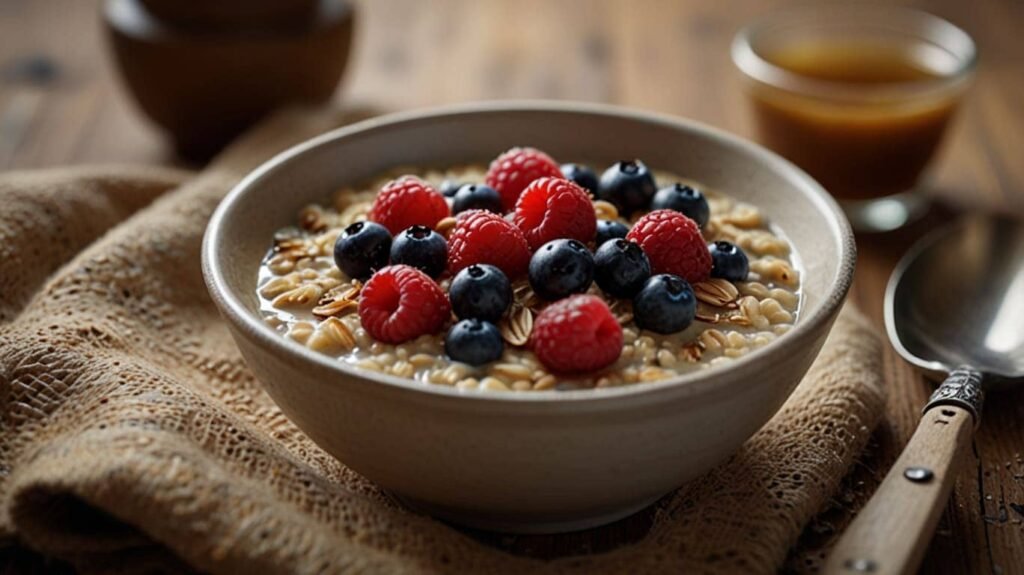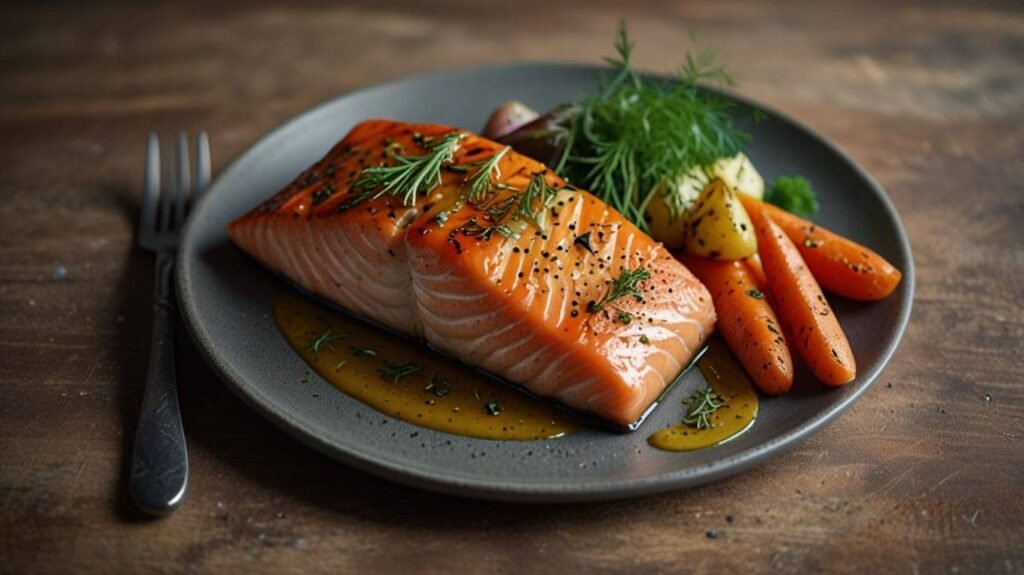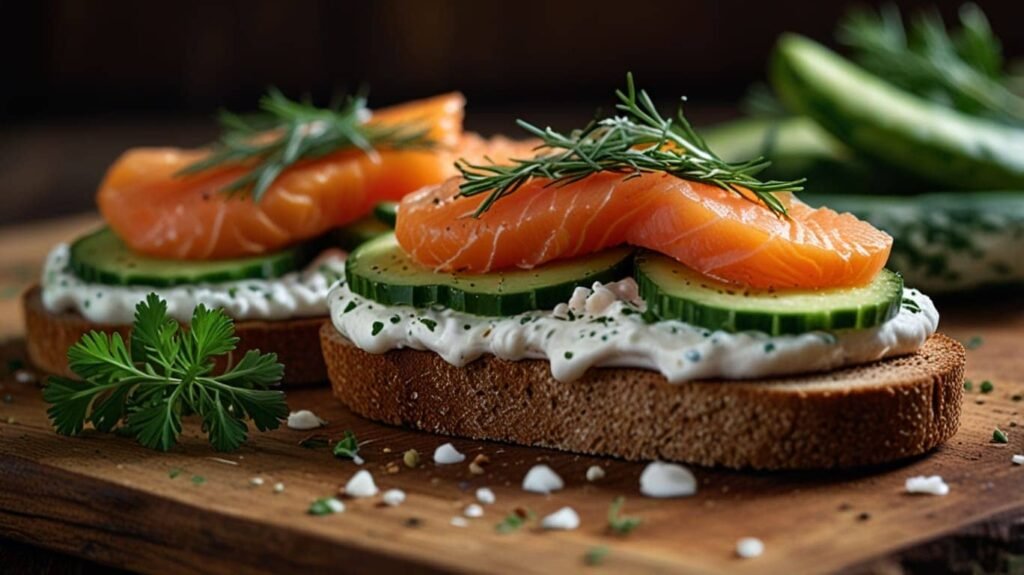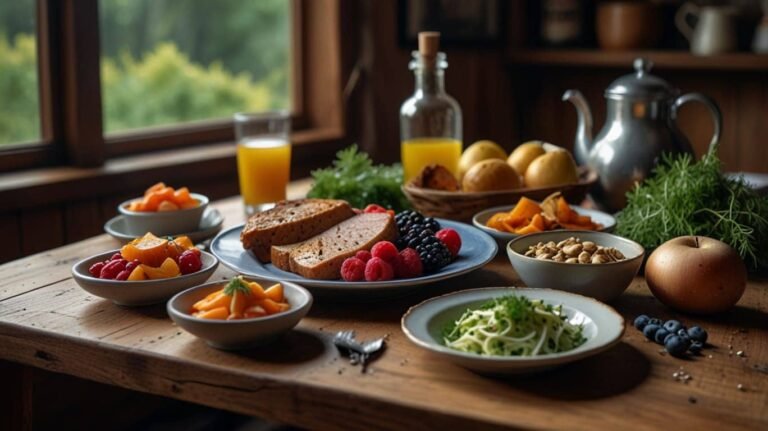Imagine strolling through a cozy Scandinavian village, surrounded by the beauty of nature’s seasonal colors. You stop at a local farmer’s market where freshly harvested vegetables, berries, whole grains, and cold-water fish line the stalls. This experience is a slice of the Nordic way of life, where simplicity, health, and local traditions come together. And at the heart of this lifestyle is the Nordic Diet Plan—a way of eating that’s not only delicious but also linked to better health and longevity.
The Nordic Diet Plan isn’t just another trendy diet; it’s a lifestyle deeply rooted in Scandinavian food traditions, focusing on locally-sourced, whole foods and nutrient-dense meals. Studies reveal that people who follow the Nordic Diet tend to have improved heart health, lower inflammation, and even reduced risks of chronic diseases. If you’re looking to embrace a diet that nourishes both body and soul, this Nordic approach offers a fresh perspective, filled with vibrant foods and simple yet fulfilling meals.
In this article, we’ll dive into the essentials of the Nordic Diet Plan. We’ll explore ten steps to help you start your journey, with practical tips, easy recipes, and insights into the benefits of eating like a true Scandinavian. Ready to discover the healthy magic of the Nordic diet? Let’s start with what this diet is all about.
What is the Nordic Diet Plan?
The Nordic Diet Plan is an eating style inspired by traditional Scandinavian diets from countries like Norway, Sweden, Denmark, and Finland. Similar to the Mediterranean diet, it emphasizes whole, plant-based foods, seasonal produce, and healthy fats. However, the Nordic diet has its own unique twist: it leans heavily on ingredients that thrive in colder climates, such as root vegetables, berries, fatty fish, and whole grains like barley and oats.
Developed in part by health experts and culinary researchers, the Nordic Diet Plan is grounded in evidence-based science. Studies have shown it supports heart health, enhances cognitive function, and even aids in weight management. The emphasis is on consuming locally-sourced foods, which promotes sustainability while offering nutrient-rich, omega-3 rich options for those looking to improve their diet. Let’s look at why this diet is gaining popularity.
Why Choose the Nordic Diet? Top Health Benefits of the Nordic Diet Plan
The Nordic Diet Plan isn’t just a tasty way to eat; it’s packed with health benefits. Here are some of the key reasons this diet stands out:
- Boosts Heart Health: Rich in omega-3 fatty acids, antioxidants, and fiber, the Nordic diet supports cardiovascular health by lowering blood pressure and reducing inflammation. Fatty fish like salmon and mackerel, staples of the Nordic diet, are packed with heart-healthy fats.
- Supports Longevity: Studies show that diets emphasizing whole grains, plant-based meals, and healthy fats—like the Nordic Diet—can add years to your life.
- Improves Gut Health: Fermented foods like yogurt and sauerkraut are common in the Nordic diet, promoting a balanced microbiome and healthy digestion.
- Aids in Weight Management: The Nordic Diet’s focus on whole, nutrient-dense foods means you feel full longer, which can help with weight control.
- Reduces Chronic Disease Risks: By lowering inflammation and oxidative stress, the diet is linked to reduced risks of type 2 diabetes, stroke, and some cancers.
With these impressive benefits, it’s no wonder that more people are drawn to the Nordic Diet Plan. Ready to give it a try? Let’s walk through ten steps to get started with this healthy, sustainable lifestyle.
10 Steps to Embrace the Nordic Diet Plan
Step 1: Embrace Whole, Seasonal Foods
Seasonal eating is a core principle of the Nordic Diet Plan. Here’s how to get started:
- Choose Fresh, Local Produce: Opt for fruits and vegetables that are in season and locally sourced. Root vegetables like carrots, beets, and turnips are excellent choices, as well as berries and leafy greens.
- The Benefits of Seasonal Eating: Seasonal foods are fresher and richer in nutrients. Additionally, eating seasonally aligns with natural growing cycles, supporting sustainable practices.
- Tips for Seasonal Shopping: Visit farmer’s markets, grow your own herbs, or join a local food cooperative for access to seasonal, Nordic-inspired produce.
Step 2: Prioritize Plant-Based Nordic Meals
Although the Nordic Diet Plan includes fish and lean meats, it’s largely plant-based. Emphasize fruits, vegetables, grains, and legumes in your meals.
- Power of Plant-Based Eating: Eating mostly plants lowers your risk of chronic disease, boosts energy, and aids in digestion.
- Delicious Plant-Based Nordic Meals: Try barley or rye salads, vegetable stews with root vegetables, or lentil soups seasoned with dill and parsley.
- Simple Plant-Based Swaps: Swap out meat in recipes for beans, legumes, or hearty vegetables like mushrooms and squash.
Step 3: Add Omega-3 Rich Diet Staples
Omega-3 fatty acids are essential for heart and brain health, and the Nordic Diet includes plenty of omega-3 rich foods.
- Benefits of Omega-3s: These fatty acids reduce inflammation, support cognitive health, and are beneficial for cardiovascular function.
- Best Omega-3 Rich Foods in the Nordic Diet: Include fatty fish like salmon, mackerel, and trout, as well as plant-based options like flaxseeds and walnuts.
- How to Incorporate Omega-3s: Add ground flaxseed to oatmeal, top salads with walnuts, and enjoy grilled or baked salmon as a main dish.
Step 4: Choose High-Quality Protein Sources
In the Nordic diet, fish and lean proteins are favored over red meats. Quality protein sources are vital for muscle maintenance, energy, and overall health.
- Nordic Protein Options: Fish, legumes, eggs, and dairy products like yogurt and kefir are popular protein choices.
- The Importance of Protein Variety: A diverse protein intake supports different body functions. Mix up animal and plant-based proteins for a balanced diet.
- Quick Protein-Rich Meal Ideas: For breakfast, try skyr (Icelandic yogurt) with berries and nuts. Lunch could be a lentil soup or a smoked salmon salad.
Step 5: Include Whole Grains and Fiber-Rich Foods
Whole grains like rye, oats, and barley are staples in the Nordic Diet Plan. They’re high in fiber, keeping you full and supporting digestive health.
- Health Benefits of Whole Grains: Whole grains are linked to reduced risks of heart disease, type 2 diabetes, and obesity.
- Popular Nordic Whole Grains: Rye bread, oat porridge, and barley pilafs are easy ways to get started.
- Tips for Adding Whole Grains: Swap refined grains for whole options, like using oats for breakfast, or trying rye bread with lunch.
Step 6: Rely on Healthy Fats and Oils
Healthy fats are emphasized in the Nordic Diet, particularly from sources like rapeseed oil (similar to canola oil), nuts, and fatty fish.
- Types of Healthy fats: Omega-3s from fish, monounsaturated fats from rapeseed oil, and polyunsaturated fats from nuts all play a role in a balanced diet.
- Why Healthy Fats are Important: These fats reduce inflammation and are vital for brain and heart health.
- Adding Fats to Meals: Use rapeseed oil in salad dressings, add a handful of nuts to snacks, and enjoy fatty fish a few times a week.
Step 7: Practice Moderation with Meat and Dairy
The Nordic Diet isn’t heavy on meat or dairy; it focuses on moderation. This shift supports both personal health and environmental sustainability.
- Benefits of Reducing Meat and Dairy: Cutting back on meat reduces cholesterol and inflammation, and moderate dairy intake supplies calcium without the heavy calorie load.
- How to Reduce Without Sacrificing Flavor: Use small amounts of high-quality cheeses or lean meats, and enhance flavor with spices and herbs.
- Recipes for Moderate Meat and Dairy Use: Try a vegetable stew with a small amount of beef or lamb, or a salad with a sprinkle of cheese.
Step 8: Enjoy Fermented Foods and Probiotics
Nordic traditions emphasize fermented foods like yogurt, kefir, and sauerkraut, all of which are excellent for gut health.
- Probiotic Benefits for Gut Health: Probiotics balance the gut microbiome, improving digestion and immunity.
- Popular Fermented Foods in the Nordic Diet: Try kefir, sauerkraut, or even Nordic pickled herring for a taste of tradition.
- Easy Fermented Food Ideas: Add a side of sauerkraut to meals, have kefir with breakfast, or enjoy a small portion of pickled fish.
Step 9: Drink Water and Herbal Teas
Staying hydrated is key in the Nordic Diet, which emphasizes water and herbal teas over sugary drinks.
- Importance of Hydration: Water helps maintain energy, supports digestion, and keeps the body’s systems functioning well.
- Nordic Herbal Tea Favorites: Try teas made from chamomile, peppermint, or lingonberries, which are soothing and caffeine-free.
- Hydration Tips: Start your day with a glass of water, enjoy herbal teas in the afternoon, and carry a water bottle for easy access.
Step 10: Embrace Nordic Food Traditions
Nordic culture values slow, mindful eating. Meals are savored, often with family or friends, and focused on gratitude.
- Cultural Benefits of Mindful Eating: Slow eating allows you to enjoy flavors and promotes better digestion.
- Social Connection through Food: Many Nordic meals are family-centered, creating a sense of community and connection.
- Mindful Eating Practices to Try: Set aside time for meals, chew slowly, and appreciate the flavors and textures of your food.
Getting Started: Simple Nordic Diet Recipes for Beginners
One of the best ways to begin your journey with the Nordic Diet Plan is by trying simple, wholesome recipes that capture the essence of Nordic flavors. Here are three beginner-friendly recipes that highlight the fresh, seasonal ingredients central to this diet.
Recipe 1: Nordic Berry Oat Porridge

Ingredients:
- 1 cup rolled oats
- 2 cups water or milk of choice
- 1 cup mixed berries (blueberries, strawberries, or lingonberries)
- 1 tablespoon flaxseeds
- A pinch of salt
- Optional toppings: nuts, seeds, or a drizzle of honey
Instructions:
- In a pot, bring the water or milk to a boil. Add oats and a pinch of salt, then reduce the heat and simmer for about 5-7 minutes, stirring occasionally.
- Once thickened, stir in the flaxseeds and berries. Cook for another 2-3 minutes, until the berries are warm.
- Serve with your favorite toppings, and enjoy a cozy, nutrient-rich breakfast.
Recipe 2: Salmon with Roasted Root Vegetables

Ingredients:
- 2 salmon fillets
- 1 tablespoon olive oil
- 1 cup carrots, chopped
- 1 cup parsnips, chopped
- 1 cup potatoes, chopped
- Fresh dill, salt, and pepper to taste
Instructions:
- Preheat the oven to 400°F (200°C). Arrange the root vegetables on a baking sheet, drizzle with olive oil, and season with salt and pepper.
- Roast the vegetables for 20 minutes. Then, add the salmon fillets to the baking sheet, seasoned with fresh dill, salt, and pepper.
- Roast for an additional 15-20 minutes, or until the salmon is cooked through and the vegetables are golden and tender. Serve and enjoy a balanced, omega-3 rich meal.
Recipe 3: Rye Bread and Smoked Trout Sandwich

Ingredients:
- 2 slices of rye bread
- 2 ounces smoked trout or smoked salmon
- 1 tablespoon Greek yogurt or skyr
- Fresh dill and sliced cucumber for garnish
Instructions:
- Spread the Greek yogurt or skyr on the slices of rye bread. Top with smoked trout or salmon.
- Garnish with cucumber slices and fresh dill for a light and healthy Nordic-style sandwich.
These recipes are perfect for newcomers to the Nordic Diet, offering a taste of classic Scandinavian flavors while being simple to prepare.
Scandinavian Diet Benefits vs. Other Popular Diets
The Nordic Diet Plan has several similarities to other popular diets but stands out in unique ways. Let’s take a quick look at how it compares:
- Nordic Diet vs. Mediterranean Diet: Both diets emphasize whole grains, healthy fats, and fish. However, the Nordic Diet uses rapeseed oil over olive oil, prioritizes cold-water fish, and incorporates more berries and root vegetables.
- Nordic Diet vs. Paleo Diet: While the Paleo Diet excludes grains and dairy, the Nordic Diet includes whole grains like rye and oats and allows dairy in moderation. The Nordic Diet is also more sustainable, focusing on locally-sourced foods.
- Nordic Diet vs. Plant-Based Diet: The Nordic Diet includes fish and occasionally lean meats but can be adapted to be more plant-focused. Plant-based Nordic meals emphasize legumes, vegetables, and whole grains, similar to a vegetarian diet.
Ultimately, the Nordic Diet Plan offers a balanced and inclusive approach that aligns well with a healthy, eco-conscious lifestyle, combining the best of plant-based and heart-healthy eating.
Nordic Diet Success Stories and Expert Opinions
Nutritionists and dietitians often praise the Nordic Diet Plan for its emphasis on natural, whole foods and the health benefits it provides. According to Dr. Anne Iversen, a dietitian specializing in Nordic nutrition, “The Nordic Diet Plan is one of the most sustainable and nutrient-dense diets globally. Its focus on seasonal produce and omega-3 rich foods has proven health benefits, from heart health to weight management.”
Studies, too, back the benefits of this diet. Research published in The American Journal of Clinical Nutrition found that participants on the Nordic Diet experienced lower cholesterol and blood pressure, better blood sugar control, and even improved cognitive function over time. With such support, it’s no wonder that the Nordic Diet Plan is gaining attention worldwide.
Key Takeaways for the Nordic Diet Plan
To wrap up, here are five key takeaways for anyone considering the Nordic Diet Plan:
- Seasonal and Local Foods are Central – Prioritizing local, seasonal ingredients supports sustainability and nutrient-rich eating.
- Focus on Plant-Based Meals – The Nordic Diet leans on vegetables, grains, and legumes as meal staples.
- Healthy Fats are a Must – Omega-3s from fish, nuts, and seeds support heart and brain health.
- Embrace Whole Grains and Fiber – Rye, oats, and barley are high in fiber and essential for a balanced diet.
- Enjoy Mindful, Slow Eating – The Nordic Diet encourages mindful eating, a practice that enhances digestion and well-being.
FAQ About the Nordic Diet Plan
1. What makes the Nordic Diet Plan different?
The Nordic Diet Plan focuses on foods native to the Nordic region, like fatty fish, root vegetables, and whole grains, promoting local, seasonal eating habits.
2. Is the Nordic diet sustainable long-term?
Yes, it’s designed with sustainability in mind, focusing on whole foods that are nutritious and environmentally friendly.
3. Can I follow the Nordic Diet as a vegetarian?
Absolutely. The diet can be adapted by emphasizing plant-based Nordic meals, legumes, and whole grains while avoiding animal products.
4. What foods should I avoid on the Nordic Diet?
Avoid heavily processed foods, refined sugars, and red meats. Focus instead on fish, whole grains, and vegetables.
5. Are there any risks to the Nordic Diet Plan?
Generally, the Nordic Diet is balanced and safe. However, those with specific dietary restrictions (e.g., low salt or low-fat diets) should consult a healthcare provider.
6. How much protein is included in the Nordic Diet?
The Nordic Diet provides ample protein from fish, legumes, dairy, and some lean meats, balanced with plant-based options.
7. Does the Nordic Diet help with weight loss?
Yes, many people find that the diet’s focus on whole, fiber-rich foods helps with weight management and satiety.
Final Thoughts: Embracing Health with the Nordic Diet
Embracing the Nordic Diet Plan is more than just changing what’s on your plate; it’s about adopting a lifestyle rooted in health, simplicity, and environmental awareness. By choosing wholesome, local ingredients, focusing on plant-based meals, and savoring each bite, you’re not only fueling your body but also connecting to a way of life that values balance and mindfulness.
As you explore the world of Nordic cuisine, remember that small changes make a big impact. Start by trying out a recipe or two, and gradually integrate these ten steps into your routine. You’ll not only enjoy delicious, nutrient-packed meals but also join a global movement toward health and sustainability.
Ready to learn more? Explore our other articles for more healthy eating tips, meal ideas, and lifestyle insights!


